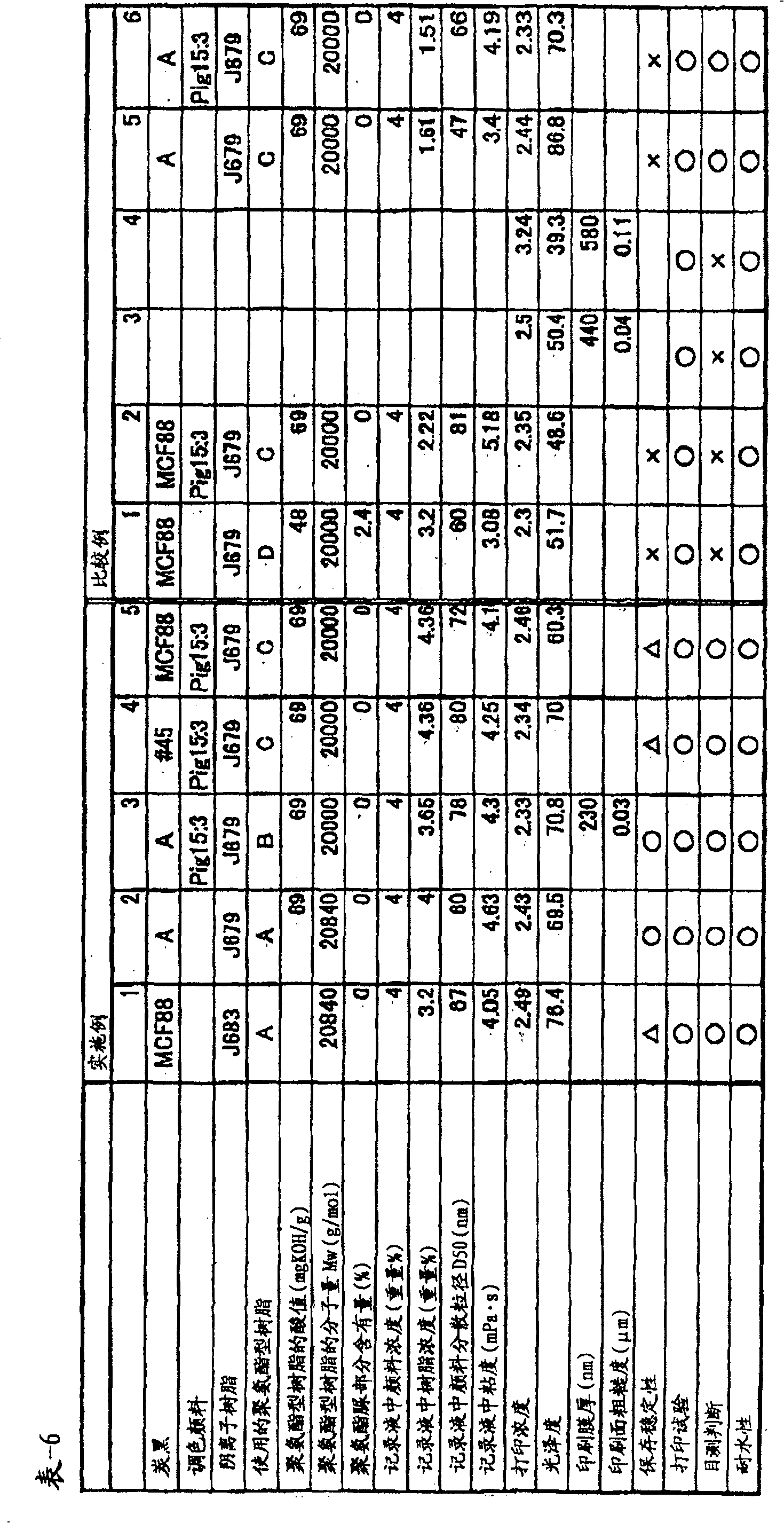Pigment disperse aqueous recording liquid and printed matter
A technology of pigment dispersion and recording liquid, which is applied in printing, thin material processing, transportation and packaging, etc. It can solve the problems that pigment inks cannot achieve sufficient gloss and blackness, and achieve the effect of satisfying water resistance
- Summary
- Abstract
- Description
- Claims
- Application Information
AI Technical Summary
Problems solved by technology
Method used
Image
Examples
specific example
[0082] Specific examples of penetration solvents (penetration aids) include ethylene glycol monomethyl ether, ethylene glycol dimethyl ether, ethylene glycol monoethyl ether, ethylene glycol diethyl ether, ethylene glycol mono-n-propyl ether, Glycol monoisopropyl ether, ethylene glycol mono-n-butyl ether, ethylene glycol mono-sec-butyl ether, ethylene glycol monoisobutyl ether, ethylene glycol mono-tert-butyl ether, ethylene glycol mono-n-pentyl ether, Glycol mono-n-hexyl ether, propylene glycol monomethyl ether, propylene glycol dimethyl ether, propylene glycol monoethyl ether, propylene glycol diethyl ether, propylene glycol mono-n-propyl ether, propylene glycol monoisopropyl ether, propylene glycol mono-n-butyl ether, propylene glycol mono-sec-butyl ether, propylene glycol Monoisobutyl ether, propylene glycol mono-tert-butyl ether, diethylene glycol monomethyl ether, diglyme dimethyl ether, diethylene glycol monoethyl ether, diethylene glycol mono-n-propyl ether, diethylene ...
Embodiment 1
[0158] Use 0.8mm zirconia beads to disperse the components shown in the following Table-3 in a bead mill disperser, monitor the particle size distribution until the average dispersed particle size is 61.9nm, then perform centrifugation and filter with 5μm filter, remove coarse particles, and obtain a carbon black dispersion.
[0159] table 3
[0160] Element
Proportion
Styrene-acrylic copolymer (ji ヨ Manufactured by Inson Bolima
" ヨ nkril 683" (acid value 160mgKOH / g, molecular weight Mw
=8000) 25% by weight aqueous solution of potassium salt)
10.4 copies
ion exchange water
71.5 copies
Glycerin
5 copies
"Prokisel GXL S"
0.1
"MCF88" manufactured by Mitsubishi Chemical Corporation
13 copies
total
100 copies
[0161] ("Prokisel GXL S" is a preservative manufactured by Abishia Corporation)
[0162] After adding and mixing 26 parts of the 30% by weight ether-based polyuret...
Embodiment 2
[0164] Use 0.8mm zirconia beads to disperse the various components shown in the following Table-4 in a bead mill disperser, monitor the particle size distribution, disperse until the average dispersed particle size is 59.8nm, and then perform centrifugal separation. Filter through a filter to remove coarse particles to obtain a carbon black dispersion.
[0165] Table 4
[0166] Element
[0167] After adding and mixing 34.67 parts of the 30% by weight ether-based polyurethane resin (A) obtained in "Synthesis of Polyurethane Resin" to this carbon black dispersion, 32.5 parts of triethylene glycol monobutyl ether, 32.5 parts of glycerin, 3.25 parts Parts of "Sa-Fino-lu 465" and 122.08 parts of ion-exchanged water were used to prepare a recording solution. The recording liquid had an average dispersed particle diameter of 60 nm and a viscosity of 4.63 mPa.s. The recording liquid was evaluated according to the evaluation methods of (1) to (9) above. The evaluation res...
PUM
| Property | Measurement | Unit |
|---|---|---|
| acid value | aaaaa | aaaaa |
| particle size | aaaaa | aaaaa |
| adsorption capacity | aaaaa | aaaaa |
Abstract
Description
Claims
Application Information
 Login to View More
Login to View More - R&D
- Intellectual Property
- Life Sciences
- Materials
- Tech Scout
- Unparalleled Data Quality
- Higher Quality Content
- 60% Fewer Hallucinations
Browse by: Latest US Patents, China's latest patents, Technical Efficacy Thesaurus, Application Domain, Technology Topic, Popular Technical Reports.
© 2025 PatSnap. All rights reserved.Legal|Privacy policy|Modern Slavery Act Transparency Statement|Sitemap|About US| Contact US: help@patsnap.com

